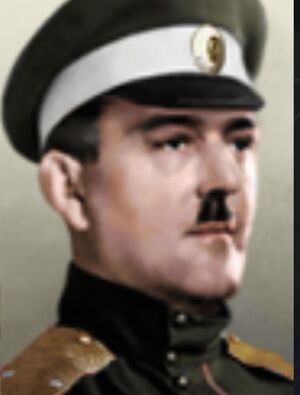Anton Turkul
( soldier, spook) | |
|---|---|
 | |
| Born | Anton Vasilevich Turkul December 24, 1892 Russia |
| Died | 20 August, 1957 (Age 64) Germany |
Exiled Tsarist army general who worked for both the British and Germans over the next few decades. | |
Prince Anton Vasilyevich Turkul was an army general in Tsarist Russia. After the 1917 revolution, he joined the counter-revolutionary White Army. In exile, he was sponsored by MI6. During World War 2, Turkul fought on the German side and commanded a unit of Vlasov's collaborationist Russian Liberation Army, the 1st SS Special Regiment Waräger, doing counterinsurgency work. After the War, he again worked for US, British and West-German intelligence agencies.
Career
Turkul was an army general in Tsarist Russia. After the 1917 revolution, he joined the counter-revolutionary White Army. [1] He was eventually evacuated via Gallipoli to Paris by the French Government. Once in Paris, he worked closely with General Alexander Kutepov's White Russian Armed Services Union.[1]
He went on to become an agent of MI6 officer Dick Ellis. In Belgrade in 1930, Turkul and another MI6 agent, Claudius Voss created a new Russian emigré group, the Narodnyi Trudovoy Soyuz (NTS).[2]
World War II
According to British sources, during the Second World War, Turkul was part of the Max-Klatt spy network, which channelled Russian disinformation to the Germans. This might be a British attempt to whitewash him because he worked for them again after the war. [3] In May 1943, Turkul attempted to make contact with Allen Dulles' OSS station in Berne. After initial failure, he turned to Prince Irakly Bagration as a go-between.[4]
During the later half of the war, Turkul commanded a unit of Vlasov's collaborationist Russian Liberation Army, the 1st SS Special Regiment Waräger, doing counterinsurgency work.[3]
Post WW II
By the end of the war, Turkul was in Austria, where he set up a "Russian National Central Committee." He was subsequently employed by the US Strategic Services Unit, looking for communist agents among the refugees heading down the post-war ratlines.[3]
In 1946, a joint British-American Special Counter-Intelligence Unit used Turkul to recruit his old colleague Voss. [5] An investigation by the US Counter-Intelligence Corps (CIC), meanwhile concluded that Turkul was an opportunist.[6]
In July, Turkul left Salzburg for Germany and tried to get to South America, a course which was seen as evidence he was not a communist agent. In September, he was arrested along with two other figures from the Max-Klatt network Richard Kauder and Ira Longin, and taken to Oberursel in the US zone, where Turkul was interrogated by the CIC and by Gilbert Ryle of MI6.[7]
Army interrogator Arnold M. Silver wrote of Turkul:
- SSU (Strategic Services Unit-the successor to the OSS until the CIA was established) in Frankfurt, with which I had close liaison, somehow became fascinated with "the Turkul case." Turkul was in fact a useless oaf who had lent his name to the Klatt network as the man who allegedly recruited sources in the USSR. He never recruited even one source, although Klatt managed to convince the Abwehr that Turkul was one of his principal agents.[8]
Turkul was released in mid-1947 and was resumed leadership of the NTS, which eventually acquired the patronage of the Gehlen Organisation. From 1948, he attempted to merge the various Russian anti-communist groups, founding the Combat Union for the Liberation of the Peoples of Russia.[9]
In late 1955, when MI6 pulled out of NTS operations in the Soviet Union, they assured the Americans that Prince Turkul had not been a Soviet double agent.[10]
Affiliations
- Russian Armed Services Union
- Narodnyi Trudovoy Soyuz
- League of St Andrew's Flag
- Russian Monarchist Organisation
- Russian Liberation Army
References
- ↑ Jump up to: a b Stephen Dorril, MI6: Inside the Covert World of her Majesty's Secret Intelligence Service, Touchstone, 2000, p.189.
- ↑ Stephen Dorril, MI6: Inside the Covert World of her Majesty's Secret Intelligence Service, Touchstone, 2000, p.405.
- ↑ Jump up to: a b c Stephen Dorril, MI6: Inside the Covert World of her Majesty's Secret Intelligence Service, Touchstone, 2000, p.419.
- ↑ Stephen Dorril, MI6: Inside the Covert World of her Majesty's Secret Intelligence Service, Touchstone, 2000, p.198.
- ↑ Stephen Dorril, MI6: Inside the Covert World of her Majesty's Secret Intelligence Service, Touchstone, 2000, p.420.
- ↑ Stephen Dorril, MI6: Inside the Covert World of her Majesty's Secret Intelligence Service, Touchstone, 2000, p.420.
- ↑ Stephen Dorril, MI6: Inside the Covert World of her Majesty's Secret Intelligence Service, Touchstone, 2000, p.420.
- ↑ Arnold M. Silver, Questions, Questions, Questions, Memories of Oberursel, CIA.gov.
- ↑ Stephen Dorril, MI6: Inside the Covert World of her Majesty's Secret Intelligence Service, Touchstone, 2000, p.421.
- ↑ Stephen Dorril, MI6: Inside the Covert World of her Majesty's Secret Intelligence Service, Touchstone, 2000, p.514.